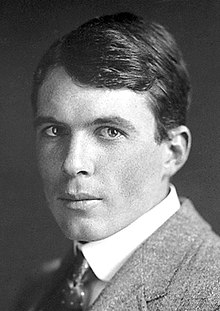Lawrence Bragg
Sir William Lawrence Bragg CH OBE MC FRS (31 March 1890 – 1 July 1971) was an Australian-born British physicist and X-ray crystallographer who won the 1915 Nobel Prize in Physics with his father Sir William Bragg.
Sir Lawrence Bragg | |
|---|---|
 William L. Bragg in 1915 | |
| Born | William Lawrence Bragg 31 March 1890 |
| Died | 1 July 1971 (aged 81) |
| Nationality | British |
| Alma mater | University of Adelaide University of Cambridge |
| Known for | X-ray diffraction Bragg's Law |
| Awards | Nobel Prize in Physics (1915) Copley Medal (1966) |
| Scientific career | |
| Fields | Physics |
| Institutions | University of Manchester University of Cambridge |
| Doctoral advisor | J. J. Thomson W.H. Bragg |
Personal life
changeBragg was always known as Sir Lawrence Bragg, and his father was Sir William Bragg. Lawrence Bragg was educated in Adelaide, Australia and in England. He was awarded the Military Cross in World War I.
He died at a hospital near his home at Waldringfield, Ipswich, Suffolk. He was buried in Trinity College, Cambridge.
Career
changeLawrence Bragg discovered (1912) the Bragg law of X-ray diffraction, the basis of X-ray crystallography. He was joint winner (with his father, Sir William Bragg) of the Nobel Prize for Physics in 1915.
Winning the Nobel at the age of 25, Lawrence Bragg is the youngest Nobel Laureate.[1] He was the director of the Cavendish Laboratory, Cambridge, when the discovery of the structure of DNA was made by James D. Watson and Francis Crick in February 1953.
He was elected an FRS in 1921.[2] He was knighted by George VI in 1941, and received both the Copley Medal and the Royal Medal of the Royal Society.
References
change- ↑ "Lawrence Bragg". Nobel Prize.org. Retrieved 5 August 2024.
- ↑ Hunter G.K. 2004 Light is a messenger. Oxford:OUP
Other websites
change- Media related to William Lawrence Bragg at Wikimedia Commons
- First press stories on DNA
- Nobelprize.org – The Nobel Prize for Physics in 1915
- A collection of digitised materials related to Bragg's and Linus Pauling's structural chemistry research.
- Key Participants: Sir William Lawrence Bragg – Linus Pauling and the Race for DNA: A Documentary History
- NOVA Episode on Photograph 51
- Oral History interview transcript with William Lawrence Bragg on 20 June 1969, American Institute of Physics, Niels Bohr Library and Archives
- Bragg, Lawrence (Sir) (1890–1971) National Library of Australia, Trove, People and Organisation record for William Lawrence Bragg
- The Nature of Things: Oil, Soap and Detergent, Ri Channel video, November 1959
- The Nature of Things: Atoms and Molecules, Ri Channel video, October 1959
- The Nature of Things: Solids, Liquids and Gases, Ri Channel video, November 1959